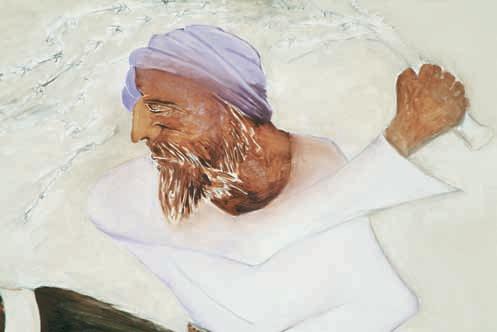
9 minute read
The Betrayal and Flagellation Norbert Lynton
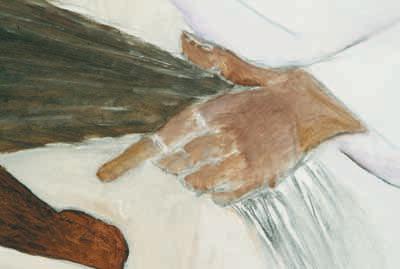
The Betrayal The and The Flagellation
Advertisement
Norbert Lynton
They say love laughs at locksmiths. However true that is, art certainly ignores fences and frontiers, eager to fi nd other modes of expression and other references to adopt and adapt. Kandinsky steeped himself in Russian folk traditions and in news of recent developments in Paris, and chose Munich, halfway between the two, as the place where he might initiate his art, at once radically new and redolent of traditions. Almost all notable modern artists have gone or looked abroad. This applies to the great art of the past as well. The Renaissance itself began with Florence’s eager embrace of the culture of antique Rome, which derived from that of ancient Greece. India’s multifarious artistic history shows many instances

of debts incurred from, and gifts made to, adjacent and more distant cultures, east and west. Art has always tended to be global, even when regionalism and nationalism aimed to rein it in. When he was seven, Krishen Khanna tried to make a copy of Da Vinci’s Last Supper from a reproduction brought home by his father; his fi rst venture into art, we are told. Later he would develop his own versions of the subject, by which time he knew also of other representations of it. His education, fi rst in Lahore and then at the Imperial Services College in Windsor, was basically Christian and English. In India, before and after his years in England, he also studied Urdu and Persian, building up a deep knowledge of, and love for, the
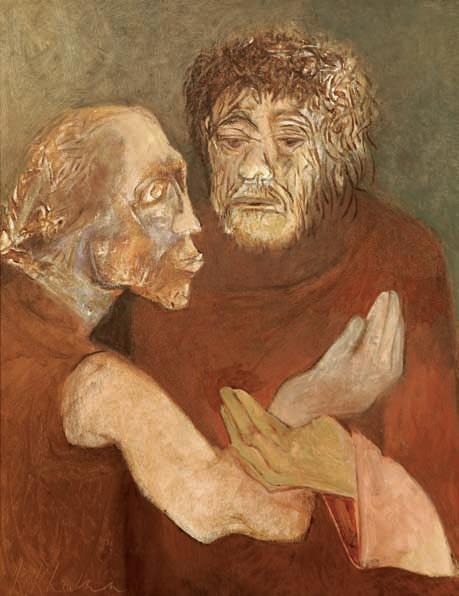


literatures of all three languages as well as the Indian languages he had acquired from childhood in the Punjab and, because of the relocations that India’s Partition and his work imposed, to Mumbai, Madras and – after he opted for full-time painting
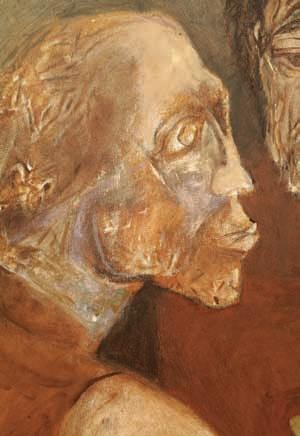
– New Delhi. In England, during school holidays, he enjoyed the friendship and guidance of Brother Joseph Gardener at Frensham, as one visitor among several other displaced and family-less youngsters. Here his understanding of Christianity took on additional depth, with closer knowledge of the New Testament and of the character of Christian saints such as St Francis, still a favourite. His college took him on repeated visits to the National Gallery in London, where he soon found himself fascinated by Piero della Francesca’s resonantly understated Baptism of Christ, as well as the strong, calm art of Giotto and Uccello, religious and secular, and delivering their messages through strong design and unchallengeable staging. He was back in India in 1942, but spent six months of 1954 in London and Paris and in Central Italy, notably in Rome, Arezzo and Assisi, confi rming
and enlarging his grasp on western, often religious, art. He speaks with awe of Piero della Francesca’s frescoes. My emphasis on his Christian education as man and artist must not overshadow his growing grasp on, and involvement in, Indian and Oriental art, culture and mythology. In Bombay, aged only 24 and a part-time painter, he became part of the Progressive Artists Group and thus made lifelong friendships with a number of artists striving to achieve their individual voices as image-makers for a country and a culture riven by Partition and open enmities and, in varying degrees, eager to fi nd in western modernism – itself a rich, contradictory and rapidly developing fi eld – idioms and methods that might leaven their inheritance. In 1964–65 he produced a number of beautiful Sumi-e paintings, abstract and done in black ink on off-white rice paper. The name is Japanese. The paintings celebrate instinctive, as opposed to considered, creation in the spirit of
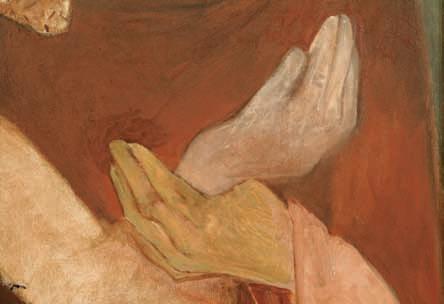
Zen. When he was awarded a US fellowship, he chose to travel via the East. For some time Khanna stayed
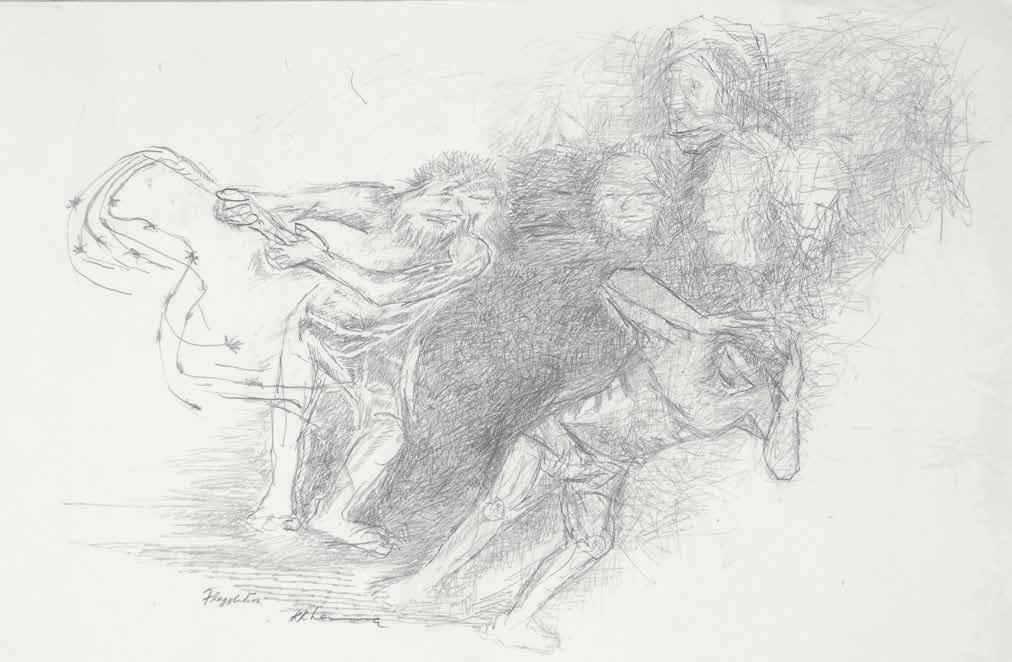
close to abstraction, partly under European and American infl uence (he knew and admired Rothko and De Kooning), but his instincts and his need to speak about the world more directly led him back to representational art on a very wide front. When he was asked to make a large mural for the Chola Sheraton Hotel at Chennai, in 1975, he chose as his theme the legendary maritime life of the Chola Empire, trading across the Bay of Bengal and along the Coromandel Coast in the 13 th and 14 th centuries. His mural is a pencil drawing made on many sheets of paper – black and white and with an infi nity of tones – to represent ancient ships and their crews amid mighty seas, and their arrival at tropical shores. The ships he had to invent; the people are people, strong but generalized and not intended to refer to a specifi c place or epoch. In 1980–84 he worked on a mural to fi t the complex vault of the main reception area of the Maurya Sheraton Hotel in New Delhi, a multi-lobed surface divided vertically by many timber beams which leave narrow spaces between them, part wall, part ceiling, for which he planned scenes all of which curved in at least one direction. Letting some scenes seem to continue behind the beams, others to be contained by them, and sometimes providing architectural or natural backgrounds for the
activities he was picturing, Khanna’s multitudinous scenes here deal with contemporary life, much of it generalized from observation of the world around him, some of it quite personal – as when he represents colleagues and friends, or himself in a wayside teahouse, averted from other fi gures as they argue and from the Sikh who owns the place and is seen making more tea. The whole work is entitled The Great Procession. Khanna wanted it to echo Chaucer’s Canterbury Tales with their inclusive presentation of humanity, its aspirations and failings. If a gentle, humorous kind of realism dominates this mural, it also includes scenes that must be satirical, as when an agile fi gure is shown juggling with three almost-living heads. Khanna was capturing, directly and symbolically, the ordinary life of Delhi together with its epic moments and the grave social disparities on which the rapidly growing city depends. Khanna’s overtly Christian paintings may appear to be the opposite of all this, historical and mythical as against the contemporary and real. After his childhood venture, his Christian paintings began in 1966 with a Pietà. He has never, I think, painted Christendom’s favoured emblem, Christ crucifi ed. The nearest he comes to picturing the death of Christ is in scenes of his Deposition, of which the Pietà

is a particularly concentrated and poignant variation. So not the dying god-man but the dead body on the lap of his tormented and protesting mother, and not the victorious Christ of the Resurrection, but the less dramatic scenes from his last days on earth, when he reveals himself to two disciples at Emmaus, and when Thomas asks to touch Christ’s wound to still his doubt. No scenes of Christ falling under the cross as he struggles to carry it to Gethsemane, but repeated versions of the Last Supper and of the Betrayals that brought Christ to that extremity. The closest Khanna comes to showing us the suffering Christ is in Flagellation, a fi ve by four foot canvas, wholly occupied by the two fi gures involved, with even the scourge played down lest it detract from the essential drama of those two, the executioner and his victim. They are presented starkly, in an almost monochrome composition, the assailant clad in white and standing over a brown-skinned Christ, blindfolded, crouching and bound tightly with white bands so that the brown of his body and the zig-zagging bands are the painting’s main visual
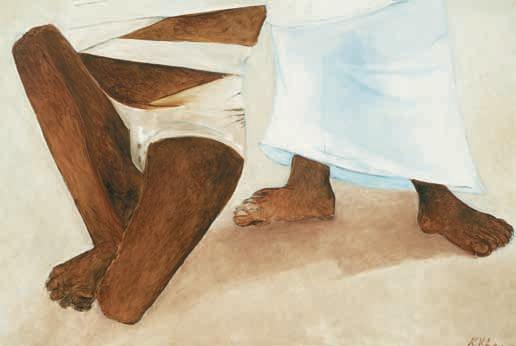
motif, together with that central hand pulling so viciously at Christ’s hair. Khanna has witnessed or known of, over the decades, many fellow humans suffering at the
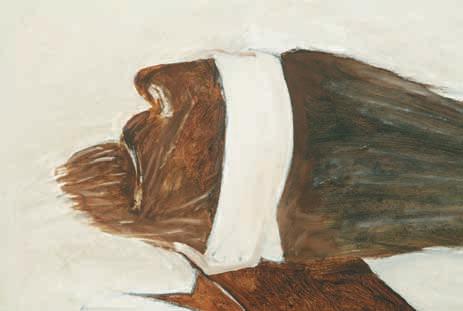
hands of offi cials acting on the orders of superior powers. Flagellation stands for all such acts of violence, often for political reasons but supposedly in the name of law and order. Betrayals are often part of such stories, and in another canvas of the same years, also fi ve by four feet, we see Judas betraying Christ with a kiss. This is another very succinct image, with the two protagonists supported by only two indistinct fi gures indicated on the left and the snout of a dog on the right. Judas’s hands gesture and reach out to Christ as his lips press forward; with his left hand (we do not see his right) Christ gently, almost apologetically wards off Judas’s lying approach, while his left foot stands forward to strengthen that patient gesture. Each of these powerful paintings delivers an emblem, succinctly scored and choreographed. The main fi gures, large on the canvas, feel
barely contained by the rectangular supports. Once seen, they are not easily forgotten: they burn their way into our store of signifi cant images. The lack of ameliorating colours and expressive brushwork, the lack of all sweetening or distraction from the key performance, gives this art an incisive and enduring character that goes far beyond the photo-based representations that are often promoted as contemporary art with a social purpose. Technically, these are narrative scenes, qualifying, in view of the importance and the familiarity of their subjects, for the art historical term ‘history painting’. Through centuries from the Renaissance on, history painting attracted ambitious artists and held the attention of their informed public, while portraits and genre scenes, of daily life as lived by anonymous contemporaries, were accorded much less attention and an inferior status. At different times and in different places history paintings could be overloaded with narrative or sensuously attractive detail, or honed down to essentials in order to produce a noble – not an entertaining – image. In concentrating his narrative so fi rmly, Khanna also de-particularizes it. Consider, for contrast, Giotto’s crowded and dramatic fresco of the Kiss of Judas in Padua or Piero’s panel of the Flagellation in
Urbino, where the eponymous action is set silently into the middle distance, while mysterious fi gures stand in the foreground of that brilliantly worked architectural space. Shunning all supporting action and staging, Khanna turns these narrative events into timeless, location-less emblems that refl ect on our own time and condemn all inhumanity.
